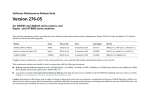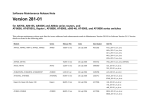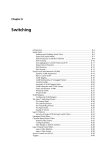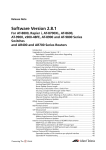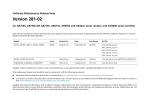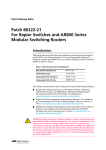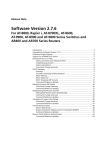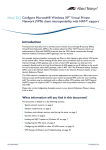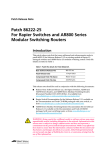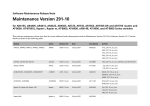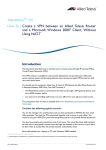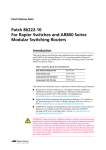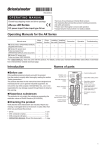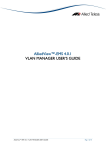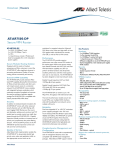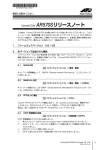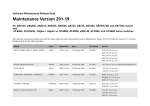Download Allied Telesis AT-9900 Series User's Manual
Transcript
Software Maintenance Release Note
Version 276-03
for AT-8900 and AT-9900 series switches
This software maintenance release note lists the issues addressed and enhancements made in Maintenance Version 276-03 for Software Release 2.7.6. Release
details are listed in the following table:
Models
Series
Release File
Date
Size (bytes)
GUI file
AT-8948
AT-8900
89276-03.rez
4 August 2006
4572948
—
AT-9924T, AT-9924SP, AT-9924T/4SP
AT-9900
89276-03.rez
4 August 2006
4572948
d9924e27.rsc
Caution: Using a maintenance version on the wrong model may cause unpredictable results, including disruption to the network.
This maintenance release note should be read in conjunction with the following documents:
■
Release Note for Software Version 2.7.6 for AT-8800, Rapier i, AT-8700XL, AT-8600, AT-9900, AT-8900 and AT-9800 Series Switches and AR400 and AR700
Series Routers (document number C613-10462-00 Rev A)
■
your switch’s Document Set for Software Release 2.7.5. This document set is available on the CD-ROM that shipped with your switch, or from:
www.alliedtelesyn.co.nz/documentation/documentation.html
Caution: Information in this release note is subject to change without notice and does not represent a commitment on the part of Allied Telesis Inc. While every
effort has been made to ensure that the information contained within this document and the features and changes described are accurate, Allied Telesis Inc. can
not accept any type of liability for errors in, or omissions arising from the use of this information.
Enabling and Installing this Release
2
Enabling and Installing this Release
To use this maintenance release you must have a base release license for Software Release 2.7.6. Contact your distributor or reseller for more information. To
enable this release and install it as the preferred release, use the commands:
enable rel=89276-03.rez num=2.7.6
set install=pref rel=89276-03.rez
Levels
Some of the issues addressed in this Maintenance Version include a level number. This number reflects the importance of the issue that has been resolved. The
levels are:
Level 1
This issue will cause significant interruption to network services, and there is no work-around.
Level 2
This issue will cause interruption to network service, however there is a work-around.
Level 3
This issue will seldom appear, and will cause minor inconvenience.
Level 4
This issue represents a cosmetic change and does not affect network operation.
Version 276-03
C613-10474-00 REV B
Features in 276-03
3
Features in 276-03
Software Maintenance Version 276-03 includes all resolved issues and enhancements in earlier versions, and the resolved issues and enhancements in the
following tables. In the tables, for each product series:
■
“Y” indicates that the resolution is available in Version 276-03 for that product series.
■
“-” indicates that the issue did not apply to that product series.
CR00013388
This issue has been resolved. The switch now reports the correct state once the
heavy load is removed.
Level 2
No level 2 issues
Level 3
No level 3 issues
Level 4
No level 4 issues
Enhancements
No enhancements
Version 276-03
C613-10474-00 REV B
AT-8948
AT-9900
AT-9800
Under heavy CPU utilisation, particularly when many SFPs were installed,
AT-9924SP switches sometimes did not correctly detect the installed status of
SFPs or reflect the correct link state.
AT-8700XL
1
AT-8600
Switch
AT-8800
CR00012654
Description
Rapier i
Level
AR750S
Module
AR7x5
CR
AR44x / AR450
Level 1
-
-
-
-
-
-
-
-
Y
-
Features in 276-02
4
Features in 276-02
Software Maintenance Version 276-02 includes all resolved issues and enhancements in earlier versions, and the resolved issues and enhancements in the
following tables. In the tables, for each product series:
■
“Y” indicates that the resolution is available in Version 276-02 for that product series.
■
“-” indicates that the issue did not apply to that product series.
AT-9900
AT-9800
Previously, if trunk ports were configured and/or STP was enabled, the CPU
flooded GARP frames in an incorrect manner, which could cause network loops.
AT-8948
1
AT-8700XL
Switch
AT-8600
CR00011691
AT-8800
Description
Rapier i
Level
AR750S
Module
AR7x5
CR
AR44x / AR450
Level 1
-
-
-
Y
Y
Y
Y
Y
Y
-
-
-
-
Y
Y
-
-
Y
Y
Y
-
-
-
Y
Y
-
-
Y
Y
Y
This issue has been resolved. GMRP frames are (correctly) flooded, and GVRP
frames are now only flooded if GARP is disabled.
CR00011694
Core,
1
Switch
If the switch had learned a very large number of routes from BGP and the
interface went down, IP ran out of memory when recalculating the best routes
to use. This was exacerbated when the high memory usage triggered the BGP
backoff mechanism which in turn disabled the BGP peers, which caused IP to
recalculate even more routes. The switch eventually rebooted due to memory
exhaustion.
This issue has been resolved by improvements to memory allocation and IP route
queuing, and by enforcing limits on the number of IP routes.
CR00012097
Switch
1
When PIM6 was configured on the switch, and it received an IPv6 multicast
stream for which it had no downstream interface to forward the stream to, a
reboot could occur.
This issue has been resolved.
Version 276-03
C613-10474-00 REV B
Features in 276-02
5
AT-8948
AT-9900
AT-9800
When a better route for multicast traffic became available, PIM for IPv6 did not
recalculate the route and switch the traffic to use it.
AT-8700XL
2
AT-8600
IPv6,
PIM6
AT-8800
Description
Rapier i
Level
AR750S
CR00000529
Module
AR7x5
CR
AR44x / AR450
Level 2
Y
Y
Y
Y
Y
-
-
Y
Y
Y
Y
Y
Y
Y
Y
-
-
Y
Y
Y
-
-
-
Y
Y
Y
Y
Y
Y
Y
This issue has been resolved.
CR00006475
IP Gateway,
2
PIM
When PIM-DM or PIM-SM was forwarding traffic through the CPU at high data
rates and an SG entry was deleted, it was possible for the router or switch to
reboot.
This issue has been resolved.
CR00007522
IP Gateway
2
The switch’s hardware IP route table occasionally did not contain the most
optimal route to a destination. This meant packets were sometimes sent via suboptimal routes. An additional effect was that when multiple equal-cost routes
existed a less than complete set of those routes would be utilised.
This issue has been resolved, so that the switch forwards packets via the best IP
route(s) available.
CR00007741
TCP,
2
TPAD TCP sessions now have a keepalive timer applied to them. If a TPAD TCP
session is inactive and therefore there is no response to the TCP keepalives, then
after 3 keepalive attempts, 10 seconds apart, the TPAD TCP session is closed. This
frees up the TCP listen port to allow subsequent TPAD transactions via that TCP
port. This TCP keepalive facility only applies to TPAD-related TCP traffic.
Y
Y
Y
Y
-
-
-
-
-
-
2
When a user is logged into the router or switch via an ASYN port and uses the
SSH client to send a command to a remote SSH server, the server sends the
response and the SSH session is closed as expected. However, the tail end of the
response was sometimes not received by the user logged into the ASYN port.
Y
Y
Y
Y
Y
Y
Y
Y
Y
Y
TPAD
CR00007950
SSH
This issue has been resolved.
Version 276-03
C613-10474-00 REV B
AT-9900
AT-9800
Previously, when 300 MAC address filters were added to a port and the port was
reset, the CPU became 100% utilised.
AT-8948
2
AT-8700XL
Switch
AT-8600
CR00008699
AT-8800
Description
Rapier i
Level
AR750S
Module
AR7x5
CR
6
AR44x / AR450
Features in 276-02
-
-
-
Y
Y
Y
Y
-
-
-
This issue has been resolved.
CR00008992
IPv6
2
The router or switch sometimes unexpectedly stopped forwarding IPv6 multicast
traffic if the multicast’s upstream path changed. This could occur, for example,
when the path changed because an interface went down.
Y
Y
Y
Y
Y
-
-
Y
Y
Y
CR00009201
ARP
2
An ARP timeout caused the removal of the ARP entry, resulting in packet loss until
the entry was re-added.
Y
Y
Y
Y
Y
Y
Y
Y
Y
Y
Y
-
-
-
-
-
-
-
-
-
-
-
-
Y
Y
Y
Y
-
-
-
Y
Y
Y
Y
Y
Y
Y
Y
Y
Y
-
-
-
Y
Y
Y
Y
-
-
-
This issue has been resolved.
CR00009280
ATM
2
When the router was using IPsec and either IPoEoA or IPoA, and it received traffic
from a VLAN at a higher rate than it could transmit over the ADSL link, eventually
the ATM interface would intermittently stop transmitting traffic.
This issue has been resolved.
CR00009283
Switch
2
If a 48-port switch learned many thousands of MAC addresses, it rebooted when
the addresses timed out.
This issue has been resolved.
CR00009539
IP Gateway
2
The IP DNS cache feature was not designed to include MX (Mail Exchange) DNS
records. In some circumstances, MX DNS entries were added to the IP DNS cache
and the name of a DNS record was incorrectly associated with the IP address of
the MX entry. This stopped the router or switch from correctly resolving A-record
requests for the affected domain name.
This issue has been resolved by ensuring that MX entries are never added to the
IP DNS cache.
CR00010265
Switch
2
When the ingress and egress port were defined in an Layer 3 filter with an action
of deny, the filter denied the traffic to be sent out all the egress ports and not
just the egress port specified in the filter.
This issue has been resolved.
Version 276-03
C613-10474-00 REV B
AT-9900
AT-9800
PPP
AT-8948
When a user enabled a Dial-on-Demand PPP interface, sometimes the router or
switch did not apply the associated IP route change. This meant that routes via
the Dial-on-Demand PPP interface were not available for use. When this
occurred, routed traffic failed to activate the associated Dial-on-Demand PPP
interface.
AT-8700XL
2
AT-8600
IPv6,
IP Gateway,
AT-8800
Description
Rapier i
Level
AR750S
CR00010886
Module
AR7x5
CR
7
AR44x / AR450
Features in 276-02
Y
Y
Y
Y
Y
-
-
Y
Y
Y
-
-
-
Y
Y
-
-
Y
Y
Y
Y
Y
Y
Y
Y
-
-
Y
Y
Y
-
-
-
Y
Y
Y
Y
-
-
-
Y
Y
Y
Y
Y
-
-
Y
Y
Y
Y
Y
Y
Y
-
-
-
-
-
-
This issue has been resolved.
CR00011060
IP Gateway,
2
PIM
In networks with redundancies handled by protocols such as STP and trunking,
upstream PIM neighbours may move from one port to another. When this
happened, PIM-DM failed to re-establish multicast routes with all of its
downstream interfaces listed properly. This caused the switch to eventually stop
sending multicasts for that group via that route.
This issue has been resolved.
CR00011128
BGP
2
When running a BGP network using route reflectors, changing the cluster ID on
a router or switch could cause a restart of some of the BGP clients.
This issue has been resolved.
CR00011304
VRRP
2
VRRP did not function correctly when the switch was configured with protected
VLANs.
This issue has been resolved.
CR00011305
IPv6,
2
Utility
RIPng (RIPv6) occasionally advertised sub-optimal routes to its neighbour when
the router or switch was placed in a looped network topology.
This issue has been resolved.
CR00011338
ASYN
2
If a cable carrying a continuous stream of characters is connected to a port on an
4-port ASYN PIC, the ASYN port did not always receive the characters correctly.
This was because of a port synchronisation failure to the character stream.
This issue has been resolved. The port now detects the synchronisation failure
and continues to attempt synchronisation to the character stream until
successful.
Version 276-03
C613-10474-00 REV B
CR
Module
Level
AR7x5
AR750S
Rapier i
AT-8800
AT-8600
AT-8700XL
AT-8948
AT-9900
AT-9800
8
AR44x / AR450
Features in 276-02
CR00011349
SYN
2
At low baud rates, a synchronous connection was unable to reach 100%
utilisation of the available bandwidth. The queueing mechanism has been
improved to allow 100% link utilisation. Flag sharing between back-to-back
HDLC frames is now supported for synchronous connections.
Y
Y
Y
Y
-
-
-
-
-
-
CR00011396
PIM on IPv6
2
When a user specified a static RP candidate and saved the configuration with the
create config command, the resulting configuration file did not include the RP
candidate. Therefore, rebooting the router or switch deleted the static RP
candidate entry.
Y
Y
Y
Y
Y
-
-
Y
Y
Y
-
-
-
-
-
Y
-
-
-
-
-
-
-
-
-
-
-
Y
Y
-
-
-
-
-
-
-
-
Y
Y
-
-
-
-
-
Y
-
-
-
-
-
Description
This issue has been resolved.
CR00011411
PoE
2
When multiple telnet sessions where open on the AT-8624PoE switch, and the
command show switch port was entered, the switch command line became
unresponsive for several minutes.
This issue has been resolved.
CR00011586
Switch
2
When a port is no longer a member of any VLAN as an untagged port, it would
discard received untagged BPDU packets.
Note that this issue only occurred on AT-8900 and AT-9900 switches; other
switches already correctly handled untagged frames on tagged ports when
required.
This issue has been resolved.
CR00011587
Switch
2
Previously, if a port was a tagged member of a VLAN, it was not able to transmit
untagged frames to that VLAN.
This issue has been resolved. When required, STP BPDUs can now to be sent
untagged out a port, even if the port is configured as a tagged member of a
VLAN.
CR00011645
Switch
2
After an AT-8800 series switch was powered down or rebooted, non autonegotiating copper GBICs did not correctly handle Ethernet PAUSE frames.
This issue has been resolved.
Version 276-03
C613-10474-00 REV B
AT-9900
AT-9800
When using an unstructured TDM group over an E1 mode PRI interface,
occasionally a high level of errors was experienced. This may have caused the link
to be unstable, or may have resulted in reduced data throughput.
AT-8948
2
AT-8700XL
PRI
AT-8600
CR00011665
AT-8800
Description
Rapier i
Level
AR750S
Module
AR7x5
CR
9
AR44x / AR450
Features in 276-02
Y
Y
Y
Y
-
-
-
-
-
-
Y
Y
Y
Y
Y
-
-
Y
Y
Y
Y
Y
Y
Y
Y
Y
Y
Y
Y
Y
Y
Y
Y
Y
Y
-
-
-
-
Y
Y
-
-
Y
Y
-
-
Y
Y
Y
This issue has been resolved.
CR00011746
BGP
2
If the router or switch failed to establish a BGP peer session because of
unsuccessful Open message exchanges, no further attempts to establish the peer
connection were made.
This issue has been resolved. The router or switch now continues to attempt to
establish the session, with 60 second intervals between attempts.
CR00011780
BOOTP
2
Previously, if a user entered the command set bootp relay option82
port=portnum without also specifying one of the required subscriberid or
trusted parameters, the router or switch would incorrectly report “Operation
Successful”.
This issue has been resolved. The router or switch now reports that one of the
parameters subscriberid or trusted must also be specified as part of this
command.
CR00011809
Firewall
2
The SIP application layer gateway (ALG) did not correctly handle SIP packets that
had an extension parameter added to the “From” field. In VoIP networks that
added this extension parameter, users telephoning out from the private network
could not hear the recipient talk, because the VoIP voice data was not passed
from the remote client to the client on the private side.
This issue has been resolved.
CR00011844
IPv6
2
IPv6 interfaces did not work over a PPP link on switches or AR44x routers. When
the interface received IPv6 traffic, the router or switch rebooted.
This issue has been resolved.
Version 276-03
C613-10474-00 REV B
AT-8700XL
AT-8948
AT-9900
AT-9800
TCP sessions would sometimes “hang” in the Close Wait state. This behaviour
occurred when a UPnP notification session was closed by the control point
(usually Windows XP, SP2), via a “200 OK” message that contained a
“Connection: close” field, that also had the TCP/FIN flag set.
AT-8600
2
AT-8800
TCP,
UPnP
Description
Rapier i
Level
AR750S
CR00011855
Module
AR7x5
CR
10
AR44x / AR450
Features in 276-02
Y
Y
Y
-
-
-
-
-
-
-
Because these TCP sessions were not closing, eventually all available TCP
resources could be used up, preventing new TCP sessions from opening.
This issue has been resolved. Such TCP sessions now close correctly.
CR00011940
Switch
2
Previously, if all configured IP interfaces were down or had been deleted,
broadcast frames were not sent to the switch’s CPU. This meant, for example,
that VLANs on the switch did not receive PPPoE traffic if all IP interfaces were
down.
-
-
-
-
-
-
-
Y
Y
-
CR00011991
WAN load
balancer
2
An issue occurred when the router accessed multiple WAN load balancer
healthcheck hosts, and was configured as a firewall that performed enhanced
NAT. Instead of testing the health of each healthcheck host through every WAN
LB resource (and therefore over all relevant WAN interfaces), the router only
tested through one WAN LB resource. If that one WAN interface lost connectivity
to the Internet, the WAN LB incorrectly thought that all WAN LB resources had
become unavailable.
Y
Y
Y
-
-
-
-
-
-
-
Y
Y
Y
Y
Y
-
-
-
-
Y
This issue has been resolved. The WAN LB now correctly checks the health of all
healthcheck hosts through all WAN LB resource interfaces.
CR00011992
Firewall
2
When the firewall was enabled, it failed to process some RTSP packets, so clients
behind the firewall failed to load some web pages that used RTSP (TCP port
7070).
This issue has been resolved.
Version 276-03
C613-10474-00 REV B
AT-9900
AT-9800
When MLD snooping was enabled and the switch received IPv6 multicast packets
(such as MLD Query, Report or Done messages; IPv6 NS packets; and IPv6 RA
packets) on a non-master port of a trunk group, it incorrectly forwarded them
out the master port. This resulted in a packet loop.
AT-8948
2
AT-8700XL
VLAN
AT-8600
CR00012013
AT-8800
Description
Rapier i
Level
AR750S
Module
AR7x5
CR
11
AR44x / AR450
Features in 276-02
-
-
-
Y
Y
-
-
Y
Y
Y
Y
Y
Y
Y
Y
Y
Y
Y
Y
Y
Y
-
-
-
-
-
-
-
-
-
-
-
-
-
-
-
-
-
Y
-
Y
Y
Y
Y
Y
-
-
Y
Y
Y
This issue has been resolved.
CR00012067
OSPF
2
A summary LSA was not turned into a route if the destination and mask fell inside
one of the router or switch’s active ranges, unless it exactly matched the active
range’s address and mask.
This complied with RFC 1583 section 16.2. However, the recommended
behaviour has been modified in RFC 2328 section 16.2. To comply with this, the
LSA is now calculated if it falls inside one of the router or switch’s active ranges.
CR00012096
Core, LLDP,
Switch, Utility
2
The LLDP module and several monitoring features started up when they were not
needed. This impacted on performance.
This issue has been resolved, and therefore performance has been improved,
especially for the AR440S router.
CR00012108
Switch
2
The command disable switch port=port-number link=disable did not
correctly disable the link for port 12 or 24 on AT-9924SP switches. It only disabled
ports 12 and 24 in software.
This issue has been resolved.
CR00012119
Load balancer
2
Previously, only one resstate trigger could be created for each load balancer
resource. This meant, for example, that you could create a trigger to activate a
script when a resource went down, but could not activate another script when
the resource came back up again.
This issue has been resolved. You can now define different triggers to trigger off
each of the different states available for a given resource (such as lbstate=up
and lbstate=closing).
Version 276-03
C613-10474-00 REV B
AT-9900
AT-9800
If the link between two PIM Sparse Mode neighbours was removed, sometimes
one of the neighbours rebooted.
AT-8948
2
AT-8700XL
PIM
AT-8600
CR00012140
AT-8800
Description
Rapier i
Level
AR750S
Module
AR7x5
CR
12
AR44x / AR450
Features in 276-02
Y
Y
Y
Y
Y
-
-
Y
Y
Y
-
-
-
Y
Y
Y
Y
-
-
-
Y
Y
Y
Y
Y
Y
Y
Y
Y
Y
Y
Y
Y
Y
Y
-
-
-
-
Y
Y
Y
Y
Y
Y
Y
Y
Y
Y
Y
This issue has been resolved.
CR00012167
Switch
2
When MAC address entries time out in the switch’s ARP table, the switch re-ARPs
for the entry’s MAC address and adds the entries back if it gets a reply. When
48-port switches re-added the entry, sometimes they associated it with the
wrong port number. This stopped the switch from transmitting traffic to that
MAC address.
This issue has been resolved.
CR00012204
CR00012232
CR00012430
PPP, Eth,
IP Gateway,
VRRP
2
Firewall,
SIP ALG
2
If VRRP and/or PPP interfaces underwent many state changes, slow memory leaks
occurred.
This issue has been resolved.
Some SIP phones may alter or periodically refresh the session information for a
call, by sending a re-invite message while the call is in progress. Previously, when
a call was established between two SIP phones on the private side of the firewall
and one of the phones attempted to update the session information, the call
became corrupted. This meant that one of the callers stopped hearing the other.
This issue has been resolved.
CR00012233
BOOTP
2
When the router or switch acted as a relay agent to process BOOTP requests that
contained option 82, it modified the option 82 information of packets even
when their giaddr field was set to a non-zero value. The router or switch applied
the policy specified by the command:
set bootp relay option82 policy={drop|keep|replace}
This issue has been resolved. As required by RFC 3046, the router or switch now
forwards client DHCP packets that have a non-zero giaddr field without
modifying their option 82 fields.
Version 276-03
C613-10474-00 REV B
AT-9900
AT-9800
TPAD previously had issues when the LRC (Longitudinal Redundancy Check) at
the end of a transaction was 0x00 and the transaction was via the TCP port. The
transaction would stall in the box and eventually time out the X.25 call.
AT-8948
2
AT-8700XL
TPAD
AT-8600
CR00012304
AT-8800
Description
Rapier i
Level
AR750S
Module
AR7x5
CR
13
AR44x / AR450
Features in 276-02
Y
Y
Y
Y
-
-
-
-
-
-
Y
Y
Y
Y
Y
-
-
Y
Y
Y
Y
Y
Y
Y
-
-
-
-
-
-
This issue has been resolved. TPAD transactions now accept an LRC with a value
of 0x00 and operate as normal.
CR00012319
IPv6
2
If the router or switch received a packet that was destined for a link-local address
that did not exist, it tried to forward the packet. This caused it to reboot. For
example, if a user pinged a non-existent link-local address, the router or switch
rebooted.
This issue has been resolved by ensuring that the router or switch does not
attempt to forward or route packets destined for a link-local interface. Such
packets should not be forwarded because they are intended for the local link.
CR00012396
Firewall,
Software QoS
2
When the router or switch was running software QoS and performing NAT
through the firewall, it did not check egress classifiers against the pre-NAT
address of translated packets.
This issue has been resolved.
Version 276-03
C613-10474-00 REV B
AT-9900
AT-9800
A few commands on the switch are local commands—they relate only to the
switch on which the user types them, and not to any other switch in the stack.
The edit command is one such command. Previously, local commands were
directed across the stack, which meant they could be sent to other stack
members. This caused the following issues with the edit command:
AT-8948
2
AT-8700XL
Core, Utility,
Stacking
AT-8600
CR00012482
AT-8800
Description
Rapier i
Level
AR750S
Module
AR7x5
CR
14
AR44x / AR450
Features in 276-02
-
-
-
Y
Y
Y
Y
Y
Y
-
Y
Y
Y
-
-
-
-
-
-
-
■ The editing window displayed the command response from other stack
members
■ If the user closed the file and tried to edit it again, the switch displayed an
error message stating that the file was being edited by another user
These issues have been resolved, resulting in the following changes:
■ Local commands now cannot be host directed. A local command that is host
directed will be refused.
■ Local commands are not sent to other stack members. Previously, local
commands were sent but were not actioned on other stack members—a "not
applicable to this host" message informed users of this.
■ The command show config dynamic is now a local command.
■ The command disable stack cannot be run from a script.
CR00012533
IP Gateway
2
Under some router configurations (for example, WAN load balancing),
performing a trace route from a Microsoft Windows PC caused the router to
reboot.
This issue has been resolved.
Version 276-03
C613-10474-00 REV B
AT-9900
AT-9800
When the WAN load balancer was used with IP NAT (instead of firewall NAT), and
an FTP session was established to a server on the public network, the router did
not correctly establish a return session. This meant data was unable to flow
correctly back from the server, and the router rebooted.
AT-8948
2
AT-8700XL
Firewall
AT-8600
CR00012613
AT-8800
Description
Rapier i
Level
AR750S
Module
AR7x5
CR
15
AR44x / AR450
Features in 276-02
Y
Y
Y
-
-
-
-
-
-
-
-
-
-
Y
Y
-
-
Y
Y
Y
Y
Y
Y
Y
Y
Y
Y
-
-
-
This issue has been resolved.
Note that the WAN load balancer is not designed for use with IP NAT, because IP
NATs are not associated with interfaces. Configurations that use an IP NAT cannot
vary the global IP address (the gblip parameter) based on the outgoing interface,
so the WAN load balancer sends all traffic out with the same source address.
Therefore, the return traffic probably comes back via the WAN load balancer
resource that is associated with the global IP. The impact is that the WAN load
balancer balances the outgoing traffic but not the return traffic.
We recommend using firewall NAT instead of IP NAT with the WAN load balancer.
CR00012649
Switch,
MLD Snooping
2
The switch sometimes flooded IPv6 multicast traffic undesirably, if the MLD All
Routers snooping group contained more than one port and another snooping
group contained no ports. In this situation, when a port timed out of the All
Routers group, multicast traffic from the empty snooping group was flooded to
all ports on the switch. Flooding continued until the last port timed out of the All
Routers group.
This issue has been resolved.
CR00012689
IP Gateway,
IGMP proxy
2
When IGMP proxy was configured and a user first deleted the upstream
interface, then deleted a downstream interface, the router or switch sometimes
rebooted. Note that this issue did not occur if the downstream interface was
deleted first.
This issue has been resolved.
Version 276-03
C613-10474-00 REV B
Features in 276-02
16
AT-8948
AT-9900
AT-9800
If the metric on a blackhole route was changed using the command set ip route
and this caused another route, which was being suppressed by the blackhole
route, to become preferred, that route could sometimes fail to be imported into
BGP.
AT-8700XL
3
AT-8600
BGP,
IP Gateway
AT-8800
Description
Rapier i
Level
AR750S
CR00006900
Module
AR7x5
CR
AR44x / AR450
Level 3
-
-
-
-
-
-
-
Y
Y
-
-
-
-
Y
Y
Y
Y
-
-
-
Y
Y
Y
Y
Y
-
-
Y
Y
Y
Y
Y
Y
Y
Y
-
-
Y
Y
Y
-
-
-
-
-
-
-
Y
Y
-
This issue has been resolved.
CR00008741
Switch
3
On 48-port switches, when a user created a static MAC address entry on a port
(using the add switch filter command) and then entered a learn limit on that
port, the static MAC address entry was sometimes deleted.
This issue has been resolved.
CR00009379
Appletalk
3
When the router or switch was using AppleTalk, it occasionally failed to process
traffic. When this occurred, entering AppleTalk commands could cause the router
or switch to reboot.
This issue has been resolved.
CR00009918
RSVP
3
When RSVP reserved more than about 30 sessions, the router or switch
sometimes rebooted.
This issue has been resolved.
CR00010080
Classifier
3
If a user defined a classifier to match ethformat=snap-untagged protocol=ip,
and used that classifier in a hardware filter to discard matching packets, and
saved the configuration, then the classifier in the resulting configuration file did
not work properly.
This issue has been resolved.
Version 276-03
C613-10474-00 REV B
AT-8948
AT-9900
AT-9800
When the router or switch received a BGP update message and created new
prefix entries for the routes in the update, it reversed the order of the AS
segments.
AT-8700XL
3
AT-8600
BGP
AT-8800
CR00010508
Description
Rapier i
Level
AR750S
Module
AR7x5
CR
17
AR44x / AR450
Features in 276-02
Y
Y
Y
Y
Y
-
-
Y
Y
Y
Y
Y
Y
Y
Y
-
-
Y
Y
Y
Y
Y
Y
Y
Y
-
-
Y
Y
Y
Y
Y
Y
-
-
-
-
-
-
-
Y
Y
Y
Y
Y
Y
Y
Y
Y
Y
This issue has been resolved.
CR00010952
IPv6
3
If either of the following were configured for MLD:
■ a qinterval greater than 32 seconds
■ a qrinterval greater than 128 seconds
then the router or switch sent MLDv2 query packets with incorrect Maximum
Response Code and Querier's Query Interval Code fields.
This issue has been resolved.
CR00010953
IPv6
3
Previously, it was possible to enter values for the set ipv6 mld qrinterval
command that were higher than was specified in RFC 2710.
This issue has been resolved. The valid range for qrinterval is now 1 to 8387
seconds.
Note that if the router or switch acts as an MLDv1 querier and qrinterval is set
to more than 65 seconds, then the Maximum Response Code in MLDv1 query
packets will be set to 65535 milliseconds, because this is the highest valid value
for that field.
CR00011105
IP Gateway
3
Configuring more than about 100 logical IP interfaces decreased the firewall
performance.
This issue has been resolved. Firewall performance is now very good even when
600 logical IP interfaces are configured.
CR00011316
3
Previously, entering the command set summertime could cause extra digits to
appear in the output of the commands show ip interface and show config
dynam=trigger.
This issue has been resolved.
Version 276-03
C613-10474-00 REV B
AT-8948
AT-9900
AT-9800
The maximum SPI value has been increased in the commands:
AT-8700XL
3
AT-8600
IPsec
AT-8800
CR00011510
Description
Rapier i
Level
AR750S
Module
AR7x5
CR
18
AR44x / AR450
Features in 276-02
Y
Y
Y
Y
Y
-
-
-
-
-
Y
Y
Y
Y
Y
Y
Y
Y
Y
Y
create ipsec saspecification=spec-id inspi=spi
outspi=spi [other parameters]
set ipsec saspecification=spec-id inspi=spi outspi=spi
[other parameters]
The spi is now an integer in the range 256 to 4294967295.
CR00011659
TTY, VRRP
3
When VRRP debug was enabled from a telnet session, the debugging did not
stop when the telnet session closed. If the next telnet session got the same TTY
number as the closed session, VRRP debug output was displayed immediately the
session started. This made it possible for unauthorised users to view the debug
output.
This issue has been resolved.
CR00011687
BOOTP
3
The command set bootp relay maxhops is now supported, in addition to the
existing command set bootp maxhops.
Y
Y
Y
Y
Y
Y
Y
Y
Y
Y
CR00011774
Switch
3
The dot1qTpFdbPort MIB entry displays the ports on which the switch has
learned MAC addresses. Previously, the switch started the list of ports at port 0
instead of port 1.
-
-
-
Y
Y
Y
Y
Y
Y
Y
-
Y
-
-
-
-
-
-
-
-
-
-
-
Y
Y
Y
Y
-
-
-
This issue has been resolved.
CR00011784
IP Gateway
3
If the router received an ARP response for an address outside of the receiving
interface's subnet, it discarded the ARP response. This is the intended behaviour
on some AR410 routers (see CR00010261) but not on AR7x5 routers.
This issue has been resolved. AR7x5 routers now forward such ARP responses.
CR00011888
Switch
3
When a trunk group on a 48-port switch spanned multiple switch instances, the
switch sometimes did not transmit traffic. The ports in each instance are:
Models
First instance
Second instance
Rapier 48i, AT-8748XL, AT-8648T /2SP
1-24, 49
25-48, 50
AT-8848
1-24, 50
25-48, 49
This issue has been resolved.
Version 276-03
C613-10474-00 REV B
AT-9900
AT-9800
After users added multiple ports to one private VLAN as tagged ports, those ports
could not be added to another private VLAN as tagged ports by using a single
command (they could be added one port at a time).
AT-8948
3
AT-8700XL
VLAN
AT-8600
CR00011931
AT-8800
Description
Rapier i
Level
AR750S
Module
AR7x5
CR
19
AR44x / AR450
Features in 276-02
-
-
-
Y
Y
Y
Y
Y
Y
-
Y
Y
Y
Y
Y
Y
Y
Y
Y
Y
Y
Y
Y
Y
Y
Y
Y
Y
Y
Y
-
-
-
-
-
-
-
Y
Y
-
Y
Y
Y
Y
Y
-
-
-
-
Y
This issue has been resolved.
CR00011943
IP Gateway
3
Previously, it was possible to modify settings for the default local IP interface
when it had no IP address. However, these settings were invalid so the router or
switch did not save them.
This issue has been resolved. Settings for the default local IP interface now cannot
be changed unless the interface has an IP address assigned to it.
CR00011969
OSPF
3
When a user changed the asexternal setting for OSPF, sometimes OSPF did not
correctly update the LSA database.
This issue has been resolved.
CR00012014
Switch
3
Setting a port’s speed to a fixed speed (such as 100mfull) should also disable
automdi on the port. Previously, if the switch set the port speed to a fixed speed
during start-up before the switch had fully initialised, auto MDI was not disabled.
This issue has been resolved.
CR00012036
Firewall
3
Previously, the command set firewall policy=policy-name
othertimeout=minutes did not change the timeout period for firewall GRE
sessions.
This issue has been resolved.
Note that when a firewall session establishes, its timeout is initially set to
5 minutes. Once the session processes two or more packets, its timeout changes
to the value specified by this command.
Version 276-03
C613-10474-00 REV B
AT-9900
AT-9800
If policy-based routing and the WAN load balancer were both configured, the
load balancer balanced traffic even if it matched the routing filter. Because the
purpose of policy-based routing is to control the route that traffic uses, this was
incorrect.
AT-8948
3
AT-8700XL
IP Gateway,
WAN load
balancer
AT-8600
CR00012040
AT-8800
Description
Rapier i
Level
AR750S
Module
AR7x5
CR
20
AR44x / AR450
Features in 276-02
Y
Y
Y
-
-
-
-
-
-
-
Y
Y
Y
Y
Y
Y
Y
Y
Y
Y
Y
-
-
-
-
-
-
-
-
-
-
-
-
-
-
-
-
Y
Y
-
-
-
-
Y
Y
Y
Y
-
-
-
This issue has been resolved. Traffic that matches a policy-based routing filter
now bypasses the WAN load balancer.
CR00012175
OSPF
3
In a segmented NBMA network, in which more than one designated router was
elected for the network, sometimes the router or switch did not add the routes
to the extra designated routers. Note that a segmented network like this only
occurs as the result of an incorrect configuration.
This issue has been resolved. The router or switch correctly determines routes in
such a network.
CR00012265
ATM
3
Previously, ATM interfaces stopped transmitting when any of the following
happened:
■ the command reset pri was entered
■ the command reset bri was entered
■ more than two ISDN calls were opened (on Software Versions prior to 2.7.6)
This issue has been resolved.
CR00012283
Switch
3
Previously, it was not possible to create two protocol-based VLANs on the same
ports if they had the same protocol but a different Ethernet encapsulation.
This issue has been resolved, so you can now create such VLANs.
CR00012305
QoS
3
When a user entered a maxbandwidth for QoS, the switch sometimes displayed
a message that said the bandwidth units were “kbytes” instead of kilobits per
second.
This issue has been resolved.
Version 276-03
C613-10474-00 REV B
AT-9900
AT-9800
Previously, when MSTP was configured it was not possible to delete ports from
VLANs in the MSTP CIST, unless MSTP was first disabled.
AT-8948
3
AT-8700XL
VLAN
AT-8600
CR00012307
AT-8800
Description
Rapier i
Level
AR750S
Module
AR7x5
CR
21
AR44x / AR450
Features in 276-02
-
-
-
Y
Y
Y
Y
Y
Y
-
Y
Y
Y
Y
Y
Y
Y
Y
Y
Y
Y
Y
Y
Y
-
-
-
-
-
-
Y
Y
Y
-
-
-
-
-
-
-
Y
-
Y
Y
Y
Y
Y
Y
Y
Y
This issue has been resolved. Deleting such ports is now permitted.
CR00012314
TACACS+,
Telnet
3
If a user connects to the router or switch via telnet and is authenticated using
TACACS+, previously the rem_addr field in the TACACS+ packets contained the
text “Telnet x” (where x was the number of the telnet session) instead of the
remote IP address.
This issue has been resolved. The rem_addr field now contains the remote IP
address.
CR00012322
Classifier
3
If a user created a classifier that specified an IP address without specifying a
protocol (for example, create classifier=1 ipda=20.20.20.10/24), and saved
the configuration with the create config command, the resulting configuration
file included a value for protocol (for example, create class=1 prot="ip"
ipda=20.20.20.10/24). This prevented the router or switch from applying the
classifier to IPsec tunnelled traffic.
This issue has been resolved. The protocol value is no longer added to such
classifiers, which leaves them matching the default of any.
CR00012329
Asyn
3
When the router sent a continuous stream of data over a permanent assignment,
and the ASYN port at the receiving end of the tunnel was significantly slower
than the ASYN port at the sending end, the sending router eventually rebooted.
This was because the router had to queue packets and eventually ran out of
memory.
This issue has been resolved. The router now stops receiving ASYN data when
memory is low, so its queue does not get too full.
CR00012359
Switch
3
You can now return the description of a switch port to its original blank value by
entering the following command:
set switch port=port-number description=
and providing no value for the description parameter.
Version 276-03
C613-10474-00 REV B
AT-9900
AT-9800
When a user creates permanent log filters, the existing default filter is moved to
the bottom of the list of filters, instead of being deleted. This behaviour is correct.
However, output of the command show config dyn=log previously included
commands to delete the default filter then add it back in, which was confusing.
AT-8948
3
AT-8700XL
Logging
AT-8600
CR00012413
AT-8800
Description
Rapier i
Level
AR750S
Module
AR7x5
CR
22
AR44x / AR450
Features in 276-02
-
Y
-
Y
Y
-
Y
Y
Y
Y
-
Y
-
Y
Y
-
Y
Y
Y
Y
Y
Y
Y
Y
Y
Y
Y
Y
Y
Y
This issue has been resolved. The output of the command show config dyn=log
now only includes the default filter if the user has specified the default filter in a
command. To see all existing filters, use the command show log
output=permanent full.
CR00012427
Logging
3
If a user modified the permanent log by destroying it and creating a new one,
and then saved the configuration with the command create config, the
resulting configuration file included the command destroy log
output=permanent. Therefore when the router or switch restarted it destroyed
the log and all entries.
This issue has been resolved. The command create config now writes the
command set log output=permanent to the configuration file instead of the
destroy and create commands.
CR00012468
OSPF
3
An OSPF router or switch could show large numbers of entries in its
retransmission lists to certain neighbours under certain conditions (for example,
in a congested Frame Relay network). In some cases, the number of items in the
list was larger than the number of LSAs in the database.
This issue has been resolved.
Also, a new NRL debugging option has been added to OSPF, to show additions
to and deletions from the neighbour retransmission list. To enable NRL
debugging, use the command:
enable ospf debug=nrl
Note that this option may generate large amounts of debugging output on a
large OSPF network. Use it with care.
To disable NRL debugging, use the command:
disable ospf debug=nrl
Version 276-03
C613-10474-00 REV B
AT-9900
AT-9800
With unidirectional traffic or small frames, an STT connection would sometimes
stop passing data.
AT-8948
3
AT-8700XL
STT
AT-8600
CR00012594
AT-8800
Description
Rapier i
Level
AR750S
Module
AR7x5
CR
23
AR44x / AR450
Features in 276-02
Y
Y
Y
Y
-
-
-
-
-
-
This issue has been resolved.
This issue has been resolved. When the channel has been encoded as a channel
map, the log message now displays one of the following:
■ a channel number if only one channel is encoded (the most common case), or
■ the entire channel map in decimal format if more than one channel is
encoded, for example:
28 11:51:21 3 ICC CALL UP
Version 276-03
C613-10474-00 REV B
ISDN call ACTIVE, direction IN , channel map 12.
AT-9900
AT-9800
Previously, the log message generated when an ISDN call came up sometimes
reported the channel as “channel unknown” when the channel was encoded as
a channel map instead of a channel number. The type of encoding depends on
the local ISDN provider, so this issue only occurred in some parts of the world.
AT-8948
4
AT-8700XL
Core, ISDN
AT-8600
CR00003286
AT-8800
Description
Rapier i
Level
AR750S
Module
AR7x5
CR
AR44x / AR450
Level 4
Y
Y
Y
Y
-
-
-
-
-
-
AT-9900
AT-9800
To simplify displaying BGP memory usage, the command show bgp memlimit
bgp has been removed. Use the command show bgp memlimit scan instead.
AT-8948
4
AT-8700XL
BGP
AT-8600
CR00011995
AT-8800
Description
Rapier i
Level
AR750S
Module
AR7x5
CR
24
AR44x / AR450
Features in 276-02
Y
Y
Y
Y
Y
-
-
Y
Y
Y
Y
Y
Y
Y
Y
-
-
Y
Y
Y
Also, you can now display only the BGP backoff log messages by using either of
the following commands:
show log type=55 subtype=backoff
show log type=55 subtype=7
CR00012043
BGP
4
When a user entered conflicting values for BGP backoff thresholds (the backoff
and low parameters of the set bgp backoff command), the error message did
not adequately show the dependency between these two parameters.
This issue has been resolved. The error message now reads (for example):
Error (3103332): BACKOFF parameter value 90 too low; must be greater than
LOW parameter value 94.
Version 276-03
C613-10474-00 REV B
Features in 276-02
25
AT-8948
AT-9900
AT-9800
Two new commands have been added to simplify MSTP management:
AT-8700XL
-
AT-8600
MSTP
AT-8800
CR00007105
Description
Rapier i
Level
AR750S
Module
AR7x5
CR
AR44x / AR450
Enhancements
-
-
-
Y
Y
Y
Y
Y
Y
-
Y
Y
Y
Y
Y
Y
Y
Y
Y
Y
-
-
-
-
-
-
-
-
Y
-
enable mstp port={port-list|all}
disable mstp port={port-list|all}
These commands enable or disable MSTP on the specified ports for the CIST and
all currently-configured MSTIs, in a single step.
Previously, this operation required two commands. For example, you can now use
enable mstp port={port-list|all} instead of the following commands:
enable mstp cist port={port-list|all}
enable mstp msti=instance port={port-list|all}
CR00009825
IP Gateway
-
When a router or switch receives a packet and does not have an ARP entry for
the destination address, it broadcasts an ARP Request message over the egress IP
interface. If it does not receive a reply within a short time, it notifies the sending
device that the destination was unknown.
This enhancement lets you configure how long the router or switch waits for a
response. Use the following new command to specify the timeout period in
seconds:
set ip arpwaittimeout=1..30
The default is 1 second. You may need to increase the timeout period if you are
communicating with devices that are slow to respond.
The easiest way to see the effect is to ping an unavailable device. The timeout
determines the delay between pinging an IP address and receiving the reply that
the device is unreachable.
CR00011164
Version 276-03
C613-10474-00 REV B
Switch
-
Improvements have been made to the throughput of AT-9924T/4SP switches
when the AT-ACC01 accelerator card is installed.
CR
Module
Level
Description
AR7x5
AR750S
Rapier i
AT-8800
AT-8600
AT-8700XL
AT-8948
AT-9900
AT-9800
26
AR44x / AR450
Features in 276-02
CR00011204
IP Gateway
-
This Software Version allows you to add ARP entries with multicast MAC
addresses and allows the router or switch to accept packets with conflicting IP
and MAC addresses. It introduces the enable ip macdisparity and disable ip
macdisparity commands to support this. For more information, see “Adding
Static ARP Entries with Multicast MAC Addresses (CR00011204)” on page 37.
Y
Y
Y
Y
Y
Y
Y
Y
Y
Y
CR00011271
Switch,
-
A new switch filter feature enables you to use a switch filter to make a VLAN
secure without preventing access to other VLANs. For more information, see
“Securing a Single VLAN through Switch Filters (CR00011271)” on page 39.
-
-
-
Y
Y
Y
Y
-
-
-
-
When an asynchronous port is in ten mode, it bundles together the characters
that it receives within a certain time period, instead of passing them one at a time
to a higher protocol layer for processing. The time period over which characters
are bundled is called the ten timer. This enhancement enables you to reduce the
length of the ten timer, to improve response times for remote terminal sessions.
Y
Y
Y
Y
Y
Y
Y
Y
Y
Y
Utility
CR00011565
ASYN
For more information, see “Making Asynchronous Ports Respond More Quickly
(CR00011565)” on page 41.
CR00011615
Switch
-
When a switch port has been given a description, it is now possible to use an
SNMP application to see the port description, through the Interfaces group of the
MIB-II MIB ifDescr OID.
Y
-
Y
Y
Y
Y
Y
Y
Y
Y
CR00011724
BGP
-
You can now display:
Y
Y
Y
Y
Y
-
-
Y
Y
Y
■ the number of routes learned from a specific peer, by using the existing
command show bgp peer=ip-address
■ information about each route learned from a specific peer, by using the new
peer parameter in the command show bgp route peer=ip-address
For more information see “Displaying Routes Learned from a Specific BGP Peer
(CR00011724)” on page 43.
Version 276-03
C613-10474-00 REV B
AT-9900
AT-9800
By default, when the router receives a tagged packet on an Eth or VLAN interface
and bridges it, the bridge strips out the packet’s VLAN tag. This enhancement
enables you to set the bridge to instead retain the tag, by using off, no or false
in the new command:
AT-8948
-
AT-8700XL
Bridging
AT-8600
CR00012620
AT-8800
Description
Rapier i
Level
AR750S
Module
AR7x5
CR
27
AR44x / AR450
Features in 276-02
Y
Y
Y
-
-
-
-
-
-
-
Y
Y
Y
Y
Y
-
-
Y
Y
Y
set bridge stripvlantag={on|off|yes|no|true|false}
The default is on. To see whether stripping is turned on or off, use the command:
show bridge
and check the new StripVlantag entry.
CR00012692
L2TP
-
The connection between the router or switch, acting as an LNS, and a third party
peer, acting as an LAC, can sometimes fail during PPP link negotiation. Frequent
negotiation failures can indicate a compatibility problem between the third party
peer and Proxy Authentication responses from the router or switch. With this
enhancement, you can now disable Proxy Authentication on the router or switch
for situations where the third party equipment is not compatible. Use
proxyauth=off in the command:
add l2tp ip=ipadd[-ipadd] ppptemplate=0..31
[number={off|on|startup}] [pre13={off|on}]
[proxyauth={off|on}]
[tosreflect={off|on|false|true|no|yes}]
The default for proxyauth is on. Proxy Authentication should not be disabled
unless necessary.
To see whether Proxy Authentication is turned on or off, use the command:
show l2tp ip
and check the new Proxy Authentication entry.
Version 276-03
C613-10474-00 REV B
Features in 276-01
28
Features in 276-01
Software Maintenance Version 276-01 includes the resolved issues and enhancements in the following tables. In the tables, for each product series:
■
“Y” in a white column indicates that the resolution is available in Version 276-01 for that product series.
■
“-” in a white column indicates that the issue did not apply to that product series.
■
a grey-shaded column indicates that Version 276-01 was not released on that product series.
“-” in a grey column indicates that the issue did not apply to that product series.
“Y” in a grey column indicates that the issue applied to that product series. These issues are resolved in the next Version (276-02).
Level 1
No level 1 issues
AT-8948
AT-9900
AT-9800
Previously, if the switch was acting as a PPPoE access concentrator, it was
forwarding the first received ICMP Echo Request packet destined for a PPPoE
client back to the sender.
AT-8700XL
2
AT-8600
PPP
AT-8800
CR00008046
Description
Rapier i
Level
AR750S
Module
AR7x5
CR
AR400
Level 2
-
-
-
Y
Y
-
-
Y
Y
Y
-
-
-
-
-
-
-
Y
Y
-
This has been resolved so the forwarding does not occur.
CR00008244
Switch
2
When a user entered the command disable switch port automdi and saved the
configuration with the create config command, the resulting configuration file
did not include that command.
This issue has been resolved.
Version 276-03
C613-10474-00 REV B
AT-9900
AT-9800
Previously, if a switch port’s learn limit was changed to a number that was less
than the currently-learned number of MAC addresses, you were unable to delete
the learned MAC addresses. The switch also did not lock the port.
AT-8948
2
AT-8700XL
Switch
AT-8600
CR00008742
AT-8800
Description
Rapier i
Level
AR750S
Module
AR7x5
CR
29
AR400
Features in 276-01
-
-
-
Y
Y
Y
Y
Y
Y
Y
-
-
-
Y
Y
-
-
Y
Y
Y
Y
Y
Y
Y
Y
-
-
Y
Y
Y
-
Y
-
Y
-
-
-
-
-
-
-
-
-
Y
Y
Y
Y
Y
Y
Y
Y
Y
Y
Y
Y
Y
Y
Y
Y
Y
-
-
-
-
-
-
-
Y
Y
-
This issue has been resolved. The switch now deletes all learned MAC addresses
and starts learning again.
CR00008791
PIM
2
Previously, Layer 2 switching of multicast traffic did not always operate correctly
when Layer 2 and Layer 3 multicast were being used at the same time.
This issue has been resolved.
CR00009236
BGP
2
For BGP prefixes learned from an external EBGP peer, which were subsequently
distributed within the router or switch’s own AS via Route Reflection, the
teaching time to the IBGP peers was excessively slow.
This issue has been resolved.
CR00009386
SSH
2
Previously, when the router or switch had encryption hardware installed, a slow
memory leak occurred after multiple consecutive SSH connections were
established.
This issue has been resolved.
CR00010232
STP
2
STP and RSTP did not work correctly when a static MAC filter was added.
This issue has been resolved, so that control traffic is not incorrectly discarded in
the presence of configured switch filters. Also, configured switch filters are now
applied to locally generated control traffic.
CR00010278
IP
2
Multihomed IP interface addresses could not be used as the default local IP
address.
This issue has been resolved.
CR00010307
Switch
2
Invalid entries were sometimes added to the hardware IP table.
This issue has been resolved.
Version 276-03
C613-10474-00 REV B
AT-8948
AT-9900
AT-9800
Sometimes the forwarding of packets occurred unnecessarily slowly. This
happened if the forwarding interface was associated with an IP filter with a
variable field pattern, such as TCP session or ICMP code and type.
AT-8700XL
2
AT-8600
IP
AT-8800
CR00010539
Description
Rapier i
Level
AR750S
Module
AR7x5
CR
30
AR400
Features in 276-01
Y
Y
Y
Y
Y
Y
Y
Y
Y
Y
-
-
-
Y
Y
Y
Y
-
-
-
Y
Y
Y
Y
Y
Y
Y
Y
Y
-
Y
Y
Y
Y
Y
-
-
-
-
-
-
-
-
Y
-
-
Y
-
-
-
For switches, note that this issue occurred when the switch was routing IP packets
in software, and had no effect on the hardware forwarding of packets.
This issue has been resolved.
CR00010784
Switch
2
Previously, if a 48-port switch was configured with one or more port-specific
hardware filters, followed by one or more non port-specific hardware filters, then
the non port-specific filter was not correctly applied to half of the ports on the
switch.
This issue has been resolved by defining the following new command, which
enables you to decide which mode you want the hardware filters to operate in:
set switch hwf mode={psf|npsf}
where:
psf = port specific first (default mode)
npsf = non port-specific first
If the first filter is non port-specific, set the mode to npsf.
CR00010888
Port
Authentication
2
When 802.1x port authentication was configured in multi-supplicant mode,
supplicants with EAP-TLS, PEAP-MS-CHAPv2 or PEAL-TLS authentication
methods were not able to access the network.
This issue has been resolved.
CR00010890
PPP
2
For a PPP interface over an ACC call, RADIUS accounting messages were not
being sent.
This issue has been resolved.
CR00010896
Switch
2
AT-40/SC, AT-40/MT and AT-41/MT uplink modules would stay link down when
they were set to a fixed speed.
This issue has been resolved.
Version 276-03
C613-10474-00 REV B
AT-8948
AT-9900
AT-9800
When port authentication was using a RADIUS server, it sometimes stopped
working after several hours. This was because port authentication generated
RADIUS Accounting Request (STOP) messages with an incorrect Acct-SessionTime value.
AT-8700XL
2
AT-8600
Port
Authentication
AT-8800
CR00010996
Description
Rapier i
Level
AR750S
Module
AR7x5
CR
31
AR400
Features in 276-01
Y
Y
Y
Y
Y
Y
Y
Y
Y
-
Y
Y
Y
Y
Y
Y
Y
Y
Y
Y
Y
Y
Y
Y
Y
Y
Y
Y
Y
Y
-
-
-
Y
Y
Y
Y
Y
Y
Y
Y
Y
Y
Y
Y
-
-
Y
Y
Y
This issue has been resolved.
CR00011040
Ping
2
When the router or switch was configured with multiple logical interfaces, it
chose the source address of the ICMP Echo Reply incorrectly in some
configurations.
This issue has been resolved.
CR00011068
SSL
2
Previously, there was a memory corruption issue in the SSL client and server
implementation.
This issue has been resolved.
CR00011111
IPX
2
Forwarding an 802.3 or ETHII encapsulated IPX packet over a VLAN to a remote
network occasionally caused the switch to reboot.
This issue has been resolved.
CR00011213
PIM 6
2
Previously, the switch treated a valid bootstrap message as a bad message if it
received the message on two or more interfaces, and when PIM6 operated in a
looped or network topology that had multiple unicast routes to the same
destination(s), it sometimes selected a sub-optimal route for RPF interface
selection for RP and BSR elections.
This issue has been addressed by an additional algorithm to deal with equal cost
multipath routes as follows:
a. if more than one route to the same given destination with equal cost exists,
then the route with highest nexthop IP address value will be selected.
b. if the nexthop IP address values are the same (the routes come from the same
device on different interfaces), then the routes with highest interface index will
be selected.
Version 276-03
C613-10474-00 REV B
AT-9900
AT-9800
Previously, if an IPsec/ISAKMP tunnel was under heavy load, an ISAKMP peer may
have retransmitted messages. When the last message in an ISAKMP exchange
was retransmitted, the remote peer did not expect to receive the second message
after the exchange had finished and caused the router or switch to reboot.
AT-8948
2
AT-8700XL
ISAKMP
AT-8600
CR00011243
AT-8800
Description
Rapier i
Level
AR750S
Module
AR7x5
CR
32
AR400
Features in 276-01
Y
Y
Y
Y
Y
-
-
-
-
-
Y
Y
Y
Y
Y
Y
Y
Y
Y
Y
Y
Y
Y
Y
Y
Y
Y
Y
Y
Y
Y
Y
Y
Y
Y
Y
Y
Y
Y
Y
-
-
-
-
-
-
-
Y
Y
-
-
-
-
-
-
-
-
-
-
Y
Y
Y
Y
Y
Y
Y
Y
Y
Y
Y
This issue has been resolved.
CR00011269
SSL
2
When the SSL server had multiple concurrent users, some SSL sessions failed to
establish, because the SSL handshakes failed.
This issue has been resolved.
CR00011300
User
2
Previously, if the router or switch was acting as an 802.1x authenticator, and it
received an illegal RADIUS packet (an Access-Reject packet with an EAP code of
“successful”), the router or switch would reboot.
This issue has been resolved. The switch now rejects such authentication
requests.
CR00011324
SSL
2
A reboot could occur when the SSLv2 client received a hello message that had an
incorrect challenge length.
This issue has been resolved, so that the SSL server’s resistance to denial of service
attacks has been improved.
CR00011328
PIM
2
When the switch was using PIM to route multicast traffic, it sometimes rebooted
if the command show switch table=nh was entered.
This issue has been resolved.
CR00011337
Environment
Monitoring
2
The switch did not record the system temperature, and therefore output of the
command show system displayed the temperature as 0°C.
This issue has been resolved.
CR00011345
MIB
2
The ATR enterprise MIB includes objects for managing ping operations. These
objects within the MIB are now fully supported.
Minor modifications have also been made to the MIB. Download the latest
atrrouter.mib file from ftp.alliedtelesyn.co.nz/pub/ar-mib/atrouter.zip.
Version 276-03
C613-10474-00 REV B
AT-9900
AT-9800
Using an online limit for a PPP interface over PPPoE over a VLAN caused the router
or switch to reboot when the online limit was reached.
AT-8948
2
AT-8700XL
PPP
AT-8600
CR00011387
AT-8800
Description
Rapier i
Level
AR750S
Module
AR7x5
CR
33
AR400
Features in 276-01
Y
Y
Y
Y
Y
-
-
Y
Y
Y
Y
Y
Y
Y
Y
Y
Y
Y
Y
Y
Y
Y
Y
Y
Y
-
-
-
-
-
Y
Y
Y
Y
Y
Y
Y
Y
Y
Y
Y
Y
Y
Y
Y
-
-
Y
Y
Y
-
-
-
Y
Y
Y
Y
Y
Y
-
-
Y
-
-
-
-
-
-
-
-
Y
Y
Y
-
-
-
-
-
-
-
This issue has been resolved.
CR00011402
SSL
2
Previously, if an SSL client closed the TCP connection before the SSL handshake
was complete then the SSL server was not forwarding the notification onto HTTP.
The TCP session was left in the close wait state and HTTP, SSL and TCP sessions
did not time out.
This issue has been resolved.
CR00011473
ISAKMP
2
Configuring an ISAKMP policy with a 24-character name sometimes caused the
router or switch to reboot. Also, it was possible to enter over-length names into
the isakmppolicy parameter of the command set ipsec policy.
Both issues have been resolved.
CR00011585
OSPF
2
Adding the same OSPF stub or host twice caused OSPF to suspend its operation,
causing neighbour relationships to eventually fail.
This issue has been resolved.
CR00011611
IP Multicast
2
The router or switch did not forward multicast traffic addressed to
239.255.255.250, even when the router or switch was not involved with UPnP
service discovery.
This issue has been resolved. The router or switch now forwards the specified
multicast traffic unless UPnP is enabled.
CR00011660
DHCP
snooping
2
Previously, setting a port’s trusted state to true twice in succession would cause
the switch to reboot.
This issue has been resolved.
CR00011666
CORE
2
AR745 routers sometimes had a high CPU utilisation after restarting, although
they were idle.
This issue has been resolved.
CR00011727
Version 276-03
C613-10474-00 REV B
UPNP
2
Deleting a firewall policy that UPnP was using could cause the router to reboot.
Features in 276-01
34
AT-9900
AT-9800
When a user logged onto the router or switch through the GUI, the router or
switch’s log recorded several HTTP 404 (Not Found) errors. This was because the
browser expected to see some images that the GUI resource file did not contain.
AT-8948
3
AT-8700XL
GUI
AT-8600
CR00006439
AT-8800
Description
Rapier i
Level
AR750S
Module
AR7x5
CR
AR400
Level 3
Y
Y
Y
Y
Y
Y
Y
Y
Y
Y
-
-
-
-
-
-
-
Y
Y
-
-
-
-
Y
Y
-
-
Y
Y
Y
Y
Y
Y
Y
Y
-
-
-
-
Y
This issue has been resolved. The expected images are now present.
CR00011055
Classifier
3
If a user attempts to change the range of TCP or UDP ports used by a classifier,
the hardware filter table may not be updated if there is a lack of hardware filter
table space. Previously, this resulted in a mismatch between the hardware and
software filter tables.
This issue has been resolved, such that if the port range change is not possible,
both the software and hardware filter tables revert back to the original filter
definitions.
CR00011123
IP Multicast
3
Previously, the switch dropped a multicast packet if the packet had IP options bits
set and the switch had recently forwarded multicast data to the group address in
the packet.
This issue has been resolved.
CR00011482
Firewall
3
The parameters maxupnpportmap and icmpunreachabletimeout were
missing from the command set firewall policy.
This issue has been resolved.
CR00011550
IP multicast
3
Performance of the switch’s internal manipulations of IP multicast routes has
been improved, and the stability of PIM-DM under extremely high loads has
correspondingly been improved.
-
-
-
-
-
-
-
Y
Y
-
CR00011609
DHCP
snooping
3
A new lease could be added to the DHCP snooping database as a full entry even
after the maximum number of leases for the port had been exceeded.
-
-
-
Y
Y
Y
Y
Y
Y
-
This issue has been resolved.
Version 276-03
C613-10474-00 REV B
AT-9900
AT-9800
The IAC (interpret as control) characters (0xFF) are escaped when sent across the
permanent assignment connection. If TCP could not send the entire buffer, the
two IAC characters were previously split up, which resulted in extra IAC
characters in the receive buffers.
AT-8948
3
AT-8700XL
PERM
AT-8600
CR00011664
AT-8800
Description
Rapier i
Level
AR750S
Module
AR7x5
CR
35
AR400
Features in 276-01
Y
Y
Y
-
-
-
-
-
-
-
This issue has been resolved. IAC characters and their escape are no longer split
over buffers.
CR00011739
IP
3
Previously, a route map entry could not be deleted if the route map was used by
BGP, OSPF or RIP. Now the route map entry can be deleted unless it is the last entry
of the route map.
Y
Y
Y
Y
Y
Y
Y
Y
Y
Y
CR00011754
VRRP
3
Previously, when a ping was sent to the virtual router address of a VRRP pair, and
VR IP address adoption was turned on (adopt=on), the reply message was sent
back from the IP address of the interface that was being used, instead of from the
IP address of the virtual router that was pinged. Some systems failed the ping
because of this address mismatch.
Y
Y
Y
Y
Y
Y
Y
Y
Y
Y
This issue has been resolved. Ping replies now come from the IP address of the
virtual router that was pinged.
AT-9900
AT-9800
Previously, if you used the ? or Tab keys to obtain help about the Quality of Service
commands, the resulting help included references to RED curves, which are not
available on the switch.
AT-8948
4
AT-8700XL
QoS
AT-8600
CR00011004
AT-8800
Description
Rapier i
Level
AR750S
Module
AR7x5
CR
AR400
Level 4
-
-
-
Y
Y
Y
Y
-
-
-
-
-
-
-
-
-
-
Y
Y
-
This issue has been resolved—the help no longer refers to RED curves.
CR00011056
Classifier
4
Previously, it was possible to create multiple classifiers that classified packets
according to the same UDP or TCP port range.
This issue has been resolved. If you attempt to create such a classifier, the switch
displays an error message.
Version 276-03
C613-10474-00 REV B
Features in 276-01
36
CR
Module
Level
Description
AR400
AR7x5
AR750S
Rapier i
AT-8800
AT-8600
AT-8700XL
AT-8948
AT-9900
AT-9800
Enhancements
CR00010196
BGP,
-
A new feature enables you to set the maximum length of the hardware route
update queue, and display the current queue size, status and maximum length.
For more information, see “Route Update Queue Length (CR00010196)” on
page 44.
-
-
-
-
-
-
-
Y
Y
-
IP gateway,
Switch
CR00011355
PERM
-
Support for permanent assignments has been added to the router. Permanent
assignments provide a method for creating permanent links between terminal
ports on routers. For information and command syntax, see “Permanent
Assignments (CR00011355)” on page 46.
Y
-
-
-
-
-
-
-
-
-
CR00011614
ASYN
-
Support for baud rates of 300, 600, 1200 and 2400 has been added to the ports
on the AR024 PIC. This PIC provides 4 asynchronous ports.
Y
Y
Y
Y
-
-
-
-
-
-
Version 276-03
C613-10474-00 REV B
Adding Static ARP Entries with Multicast MAC Addresses (CR00011204)
37
Adding Static ARP Entries with Multicast MAC Addresses (CR00011204)
This Software Version allows you to add ARP entries with multicast MAC addresses and allows the router or switch to accept packets with conflicting IP and
MAC addresses. It introduces the enable ip macdisparity and disable ip macdisparity commands to support this.
Adding Static ARP Entries
Valid ARP entries are normally restricted to unicast IP with unicast MAC addresses. However, ARP entries can be configured with multicast MAC addresses
when macdisparity is enabled. Static ARP entries with multicast MAC addresses are necessary for some third party networking solutions, such as server
clustering.
Before you can add an ARP entry with a multicast MAC address, you must enable macdisparity using the command:
enable ip macdisparity
Once this feature is enabled, you can add an ARP entry with a multicast MAC address using the add ip arp command.
Accepting Packets with Conflicting Addresses
Enabling macdisparity also allows the router or switch to accept packets with conflicting IP and MAC addresses. Normally the router or switch discards these
packets as being invalid.
Conflicting IP and MAC addresses include:
■
A multicast IP address with a unicast MAC address
■
A unicast IP address with a multicast MAC address
Macdisparity is disabled by default. When disabled, only ARP entries with unicast IP and MAC addresses can be added, and packets with conflicting
addresses are discarded. Other routers or switches in the network may not accept packets with conflicting addresses unless configured to. To disable this
functionality, use the command:
disable ip macdisparity
ARP entries with multicast MAC addresses must be removed before the disable ip macdisparity command will work. To see details on the current ARP entries,
use the command:
show ip arp
Version 276-03
C613-10474-00 REV B
Adding Static ARP Entries with Multicast MAC Addresses (CR00011204)
To see whether macdisparity is enabled or disabled, use the command:
show ip
For an example of how to use ARP entries with multicast MAC addresses, see Guideline to Windows 2003 Network Load Balancing Clustering with Allied Telesyn
Switches. This is available from the Resource Center on your Documentation and Tools CD-ROM, or from:
www.alliedtelesyn.co.uk/en-gb/solutions/techdocs.asp?area=howto
Version 276-03
C613-10474-00 REV B
38
Securing a Single VLAN through Switch Filters (CR00011271)
39
Securing a Single VLAN through Switch Filters (CR00011271)
On AT-8824, Rapier 24i, AT-8724XL and AT-8624 switches, this enhancement enables you to use switch filters to secure only the current VLAN, instead of
securing all VLANs on the switch. To turn on this feature, a new command disables “vlansecure” for filters (see “Configuring vlansecure” on page 40). Without
this enhancement (the default situation) a switch filter only allows a host to access the network through a particular port on the switch. For example, if you have
a PC connected to port 15 in vlan2, and define the following filter, the PC can only communicate when it is connected to port 15:
add switch filter entry=0 dest=pc-mac-address vlan=2 port=15 action=forward
With this enhancement, the above filter limits the host to accessing vlan2 through port 15, but does not prevent the host from accessing other VLANs through
other ports in vlan2. For example, if the above filter exists and you move the PC to another port in vlan2, this enhancement prevents the PC from
communicating with devices in vlan2 but allows it access to other VLANs on the switch. The following figure shows a PC that has been moved from port 15 to
port 16 to illustrate the effect.
Default behaviour
Securing only the VLAN
(vlansecure enabled)
(vlansecure disabled)
port 15
port 16
port 15
vlan2
vlan2
vlan1
vlan1
port 16
swi-filter
Version 276-03
C613-10474-00 REV B
Securing a Single VLAN through Switch Filters (CR00011271)
Configuring vlansecure
To turn off the default behaviour, so that the filter prevents access to only the current VLAN when you move the host, use the new command:
disable switch filter vlansecure
To return to the standard filter behaviour, use the new command:
enable switch filter vlansecure
To display which mode the filtering behaviour is in, use the existing command:
show switch filter
This command now displays the additional field “VlanSecure”, which is either DISABLED or ENABLED.
Version 276-03
C613-10474-00 REV B
40
Making Asynchronous Ports Respond More Quickly (CR00011565)
41
Making Asynchronous Ports Respond More Quickly (CR00011565)
When an asynchronous port is in ten mode, it bundles together the characters that it receives within a certain time period, instead of passing them one at a time
to a higher protocol layer for processing. The time period over which characters are bundled is set by the ten timer.
Bundling reduces the load on the CPU by spreading the character processing overhead across several characters. If a remote terminal session is involved,
bundling also reduces the number of packets on the network by sending more characters in each packet. However, it reduces terminal responsiveness. A ten
timer value of 100 milliseconds is generally a good compromise between responsiveness and processing overhead. If you need to increase the port’s
responsiveness, this enhancement enables you to reduce the length of the ten timer. To do this, use the new optional tentimervalue parameter in the set asyn
command:
set asyn[=port-number] tentimervalue=20..100 [other optional parameters]
Specify the asynchronous port number unless you are logged in via the port you want to change.
The default tentimervalue is 100 milliseconds, which is the value it was set to before this enhancement.
To display a port’s value for the ten timer, use the command:
show asyn=port-number
and check the new “Ten timer value” field, as shown in Figure 1. If the asynchronous port is a terminal server port in ten mode, the “Mode” field displays
“Ten”.
Version 276-03
C613-10474-00 REV B
Making Asynchronous Ports Respond More Quickly (CR00011565)
Figure 1: New parameters in the output of the show asyn=0 command
ASYN 0 : 0000001470 seconds
ASYN information
Name ......................
Status ....................
Mode ......................
Data rate .................
Parity ....................
Data bits .................
Stop bits .................
Test mode .................
In flow state (mode) ......
Out flow state (mode) .....
Autobaud mode .............
Max tx queue length .......
TX queue length ...........
Transmit frame ............
RX queue length ...........
IP address ................
Max transmission unit .....
Ten timer value ...........
.
.
.
Version 276-03
C613-10474-00 REV B
Last change at: 0000001465 seconds
Asyn 0
enabled
Ten
9600
none
8
1
no
on (Hardware)
off (Hardware)
disabled
16
3
none
0
none
1500
100
42
Displaying Routes Learned from a Specific BGP Peer (CR00011724)
Displaying Routes Learned from a Specific BGP Peer (CR00011724)
This enhancement enables you to display:
■
the number of routes learned from a specific peer
■
information about each route learned from a specific peer
Displaying the Number of Routes from a Peer
To display the number of routes learned from a specific peer, use the existing command:
show bgp peer=ip-address
and check the new “Routes learned” field (Figure 2).
Figure 2: New parameter in the output of the show bgp peer command for a specific peer
Peer ................
Description .........
State ...............
Policy Template .....
Description .........
Private AS filter ...
Remote AS ...........
BGP Identifier ......
Routes learned ......
Authentication ......
Password .......... .
.
.
192.168.10.1
Idle
4
Test Template 1
Yes
3
172.20.25.2
15
None
Displaying Information about the Routes from a Peer
To display information about each route learned from a specific peer, use the new peer parameter in the command:
show bgp route[=prefix] [peer=ip-address] [other optional parameters]
The peer parameter specifies the IP address of the peer. If you specify a peer, the router or switch only displays routes that it learned from that peer. If you
specify the router or switch’s router ID, it displays all locally originated routes. The peer parameter has no default.
Note that this enhancement did not change any fields in the output of the show bgp route command; it simply provides another method of filtering the
displayed routes.
Version 276-03
C613-10474-00 REV B
43
Route Update Queue Length (CR00010196)
44
Route Update Queue Length (CR00010196)
When hardware learning delay is enabled (the default), the switch learns new routes in software, then places them into a queue for adding them to its hardware
routing table. Defaults have been set for the maximum number of entries in the queue, and depend on the amount of memory installed on the switch, as shown
in the following table:
Memory Size (Mbytes)
Default length (number of entries)
Maximum possible length (number of entries)
up to 128
200000
200000
129-256
1000000
1500000
more than 256
3000000
4000000
You can alter the length of the queue, by using the following new command to specify the maximum number of entries in the queue:
set switch hwrouteupdate=1..maximum
The maximum depends on the amount of memory on the switch, as shown in the table above.
Output of the show switch command has been expanded to display information about the queue settings (Figure 3, Figure 4, Table 1).
Figure 3: Output of the show switch command when hardware learning delay is disabled
Switch Configuration
----------------------------------------------------------Switch Address ............. 00-00-cd-12-78-03
Learning ................... ON
Ageing Timer ............... ON
IP route:
Learn delay ............. OFF
queue limit ....... 1000000
queue maximum ..... 1500000
queue default ..... 1000000
Updating hardware(status) 0 (Pending)
.
.
.
Version 276-03
C613-10474-00 REV B
Route Update Queue Length (CR00010196)
Figure 4: Output of the show switch command when hardware learning delay is enabled
Switch Configuration
----------------------------------------------------------Switch Address ............. 00-00-cd-12-78-03
Learning ................... ON
Ageing Timer ............... ON
IP route:
Learn delay ............. 4 ms
queue size ........ 0
queue limit ....... 1000000
percent in use .... 0
high water mark ... 0
queue maximum ..... 1500000
queue default ..... 1000000
Updating hardware(status) 0 (Pending)
.
.
.
Table 1: New parameters in the output of the show switch command
Parameter
Meaning
Queue size
The number of entries currently in the hardware route update queue.
Queue limit
The maximum number of entries that the queue can hold.
Percent in use
The percentage of the queue limit that is currently used.
High water mark
The highest number of messages that have been seen on the queue since the switch last started up.
Queue maximum
The maximum value to which you can set the queue size. This depends on the amount of memory installed on the switch.
Queue default
The default maximum number of entries in the queue. This depends on the amount of memory installed on the switch.
Updating hardware (status)
The number of entries that the software has queued for writing into the hardware table, followed by the status. Status
is Pending if the hardware is not currently processing queued routes and Active if it is currently processing the routes.
Version 276-03
C613-10474-00 REV B
45
Permanent Assignments (CR00011355)
46
Permanent Assignments (CR00011355)
Permanent assignments provide a method for creating permanent links between terminal ports on routers. Any two terminal ports on a single router or on
routers that can communicate with each other via TCP/IP can be set up to have a permanent assignment between them. Asynchronous traffic coming into each
port is sent via TCP to other port and then sent out that port.
The most common use of permanent assignments is to provide access to network printers. However, permanent assignments can connect any asynchronous
devices together. Other examples include connecting a terminal to a host computer asynchronous port and connecting an asynchronous port on a data logger to
a computer for capturing the results of experiments.
Setting up a Permanent Assignment
To set up a permanent assignment, the port numbers of the ports and the IP addresses of the routers at each end of the link must be specified. Each permanent
assignment is also given a name. The name is used for management convenience and for identification purposes when the permanent assignment’s TCP
connection is made at router boot or when the permanent assignment is created or reset. A short dialogue takes place between the two routers involved in the
permanent assignment when the assignment is set up, to verify that the correct ports are being connected. This dialogue uses the permanent assignment name
for verification. The name is case sensitive and must be identical for both ends of the permanent assignment.
Each end of the permanent assignment must be set up for the assignment to work correctly. A common cause of problems for permanent assignments is one
end of the assignment being set up incorrectly.
A given permanent assignment has a different view looking from each end of the assignment. The terms local and remote are used to denote the ends of the
assignment from one point of view. Thus there is a local and remote port and a local and remote router for each permanent assignment. Note that the local
router is the router that the command is being entered on.
To set up one end of a permanent assignment use the command:
add perm=name
The name of the permanent assignment, the local and remote ports and the IP address of the remote router must all be specified in this command.
To display the configuration of the permanent assignment (Figure 5), use the command:
show perm
Version 276-03
C613-10474-00 REV B
Permanent Assignments (CR00011355)
47
Figure 5: Example output from the show perm command
Port
Name
Local Remote IP address
----------------------------------------------laser-print
12
04
172.16.8.37
-----------------------------------------------
If the two ports of the permanent assignment are on different routers, the add perm command must be entered on each router. If both ports are on the same
router, the command only needs to be entered once. The IP address specified may be any one of the IP addresses of the router in question.
A permanent assignment can be removed with the command:
delete perm=name
This command removes the permanent assignment from the local router. If the other port of the permanent assignment is on a remote router, the permanent
assignment should also be removed from the remote router.
A permanent assignment can be reset with the command:
reset perm
This command breaks the current TCP connection being used for the permanent assignment and attempts a new connection. The terminal port being used for
the permanent assignment is also reset.
Example
This example illustrates the process of setting up a permanent assignment. The assignment is to be established between port 2 on a router with IP address
172.26.4.1 and port 2 on a router with IP address 172.20.34.9, and is to be named main office. The commands to be executed on the router with address 172.26.4.1
are:
add perm=main office lport=2 rport=3 ip=172.20.34.9
show perm
which produces the output shown in Figure 6.
Version 276-03
C613-10474-00 REV B
Permanent Assignments (CR00011355)
Figure 6: Example output from the show perm command for router 172.26.4.1
Port
Name
Local Remote IP address
----------------------------------------------main office
02
03
172.20.34.9
-----------------------------------------------
The commands to be executed on the router with address 172.20.34.9 are:
add perm=main office lport=3 rport=3 ip=172.26.4.1
show perm
which produces the output shown in Figure 7.
Figure 7: Example output from the show perm command for router 172.20.34.9
Port
Name
Local Remote IP address
----------------------------------------------main office
03
02
172.26.4.1
-----------------------------------------------
Since the name of the permanent assignment in this example contains embedded spaces, the whole name must be in double quotes when entered in a
command.
Version 276-03
C613-10474-00 REV B
48
Permanent Assignments (CR00011355)
49
Command Reference
This section describes commands available on the router to configure and manage permanent assignments.
add perm
Syntax
ADD PERM=perm-name LPORT=lport RPORT=rport IP=ipadd
where:
■
perm-name is the name of the permanent assignment. The name is case- sensitive and must be identical on each router in the permanent assignment. If the
name contains spaces, it must be in double quotes.
■
lport is the number of the local asynchronous port for this permanent assignment. Ports are numbered sequentially starting with port 0.
■
rport is the number of the remote asynchronous port for this permanent assignment. Ports are numbered sequentially starting with port 0.
■
ipadd is the IP address of the remote router.
Description
This command adds one end of a permanent assignment. The permanent assignment must be specified by name, and the local and remote terminal ports and
the IP address of the remote router must be specified.
The local and remote ends of a permanent assignment must be configured with the same name. Each permanent assignment on a given router must be
configured with a different name.
Examples
To add a permanent assignment called DataLogger between port 1 on the local router and port 1 on a remote router with the IP address 172.16.38.5, use the
command:
add perm=datalogger lport=1 rport=1 ip=172.16.38.5
Version 276-03
C613-10474-00 REV B
Permanent Assignments (CR00011355)
50
Related Commands
delete perm
reset perm
set perm
show perm
delete perm
Syntax
DELete PERM=perm-name
where perm-name is the name of the permanent assignment. The name is case sensitive and must be identical on each router in the permanent assignment. If the
name contains spaces, it must be in double quotes.
Description
This command removes a named permanent assignment from the local router. The permanent assignment must also be removed from the remote router.
Examples
To delete the permanent assignment called DataLogger, use the command:
del perm=datalogger
Related Commands
add perm
reset perm
set perm
show perm
Version 276-03
C613-10474-00 REV B
Permanent Assignments (CR00011355)
51
reset perm
Syntax
RESET PERM=perm-name
where perm-name is the name of the permanent assignment. The name is case sensitive and must be identical on each router in the permanent assignment. If the
name contains spaces, it must be in double quotes.
Description
This command resets a named permanent assignment. The port being used by the permanent assignment is reset and the TCP connection being used for the
permanent assignment is reset. A new TCP connection is established for the permanent assignment.
Examples
To reset the permanent assignment called DataLogger, use the command:
reset perm=datalogger
Related Commands
add perm
delete perm
set perm
show perm
Version 276-03
C613-10474-00 REV B
Permanent Assignments (CR00011355)
52
set perm
Syntax
SET PERM=perm-name [LPORT=lport] [RPORT=rport] [IP=ipadd]
where:
■
perm-name is the name of the permanent assignment. The name is case sensitive and must be identical on each router in the permanent assignment. If the
name contains spaces, it must be in double quotes.
■
lport is the number of the local asynchronous port for this permanent assignment. Ports are numbered sequentially starting with port 0.
■
rport is the number of the remote asynchronous port for this permanent assignment. Ports are numbered sequentially starting with port 0.
■
ipadd is the IP address of the remote router.
Description
This command changes the configuration of an existing permanent assignment. The permanent assignment must be specified by name. At least one other
parameter must be specified.
The remote end of the permanent assignment must also be configured on the remote router.
Examples
To change the local and remote asynchronous ports used by the permanent assignment called DataLogger to port 0, use the command:
set perm=datalogger lport=0 rport=0
Related Commands
delete perm
reset perm
show perm
Version 276-03
C613-10474-00 REV B
Permanent Assignments (CR00011355)
53
show perm
Syntax
SHOW PERM[=perm-name]
where perm-name is the name of a permanent assignment
Description
This command displays the name, local and remote ports and remote IP address for all permanent assignments currently defined on the router. If a permanent
assignment is specified by name, only that permanent assignment is displayed (Figure 8, Table 2).
Figure 8: Example output from the show perm command
Port
Name
Local Remote IP address
----------------------------------------------laser-print
12
04
172.16.8.37
-----------------------------------------------
Table 2: Parameters in output of the show perm command
Parameter
Meaning
Name
Name of the permanent assignment.
Local
Local port for the permanent assignment.
Remote
Remote port for the permanent assignment.
IP address
IP address of the remote router.
Examples
To display all the permanent assignments configured on the local router, use the command:
show perm
Version 276-03
C613-10474-00 REV B
Permanent Assignments (CR00011355)
Related Commands
add perm
delete perm
reset perm
set perm
Version 276-03
C613-10474-00 REV B
54






















































